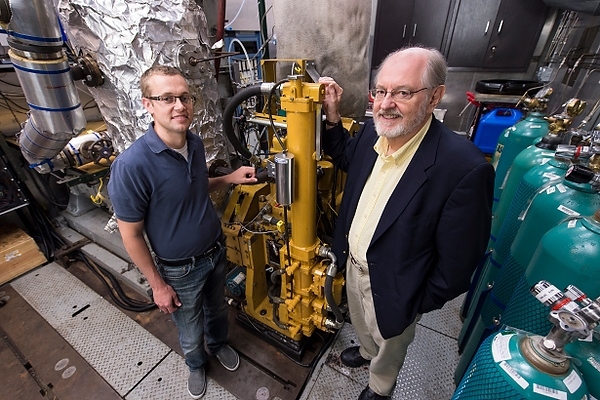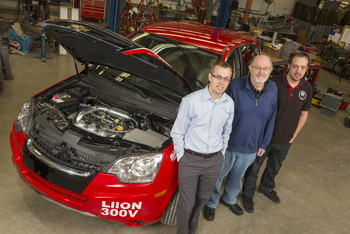Best-ever efficiency points to clean, green gas-diesel engine

Sage Kokjohn, left, and Rolf Reitz check a room with test monitors and air regulators that are connected to an operating, one-cylinder diesel engine in the Caterpillar Engine Lab at the Engineering Research Building.
The one-cylinder test engine in the basement of a University of Wisconsin–Madison lab is connected to a life-support system of pipes, tubes, ducts and cables. You might think that the engine resembles a patient in intensive care, but in this case, the patient is not sick.
Instead, the elaborate monitoring system shows that the engine can convert 59.5 percent of the chemical energy in its fuel into motion — significantly better than the 52 percent maximum in modern diesel truck engines.
New engine technologies are frequently developed in one-cylinder engines like this one. And after being doctored by a group led by Rolf Reitz, a professor of mechanical engineering at UW–Madison, this is the most efficient diesel in the engine-research world.

Air regulators and test monitors are connected to the engine — the most efficient diesel in the engine-research world.
“This process is 10 percent to 15 percent more efficient than the best commercial diesel engines, which are the most efficient internal combustion engines,” Reitz says.
But the test engine is not strictly speaking a diesel engine. Instead, it burns diesel and gasoline in a ratio that is precisely controlled to exploit each fuel’s strong points. Sensors and a computer can vary the mixture with split-second timing, creating an engine that runs much cooler than conventional gas or diesel engines. That temperature reduction is key to efficiency, because less heat is lost to the engine block and the radiator, Reitz says.
He calls the system reactivity controlled compression ignition, or RCCI. A group of students in the Engine Research Center on campus have just installed an engine using these principles into an electric hybrid version of a 2009 Saturn, and have begun road tests.
“Putting this in the test car was a major project. It’s amazing that a bunch of students could do this and make it work,” says Reitz. “I worked for six years at GM, and hundreds of engineers would be needed for a project like this.”
Road tests will expand on results from the lab, he says, adding, “The engine has a lot of controls, so when you put your foot on the gas, we automatically change the amount of diesel and gasoline to optimize the combustion process. We can blend the correct dosage on a cycle-by-cycle basis.”

Reitz and his team installed an engine using the same principles into a 2009 Saturn electric hybrid and have begun road tests.
Photo: David Tenenbaum
The engine uses readily available diesel and gasoline, but Reitz’s group has also experimented with additives that bring similar advantages in much smaller quantities. The RCCI technology could be used in a wide range of engines for automobiles, heavy-duty trucks and buses, off-road vehicles, locomotives, generators and even ships. The technology was funded by the Department of Energy and other organizations. Patents have been assigned to the Wisconsin Alumni Research Foundation, which is handling licensing.
High efficiency is only one benefit of the RCCI system. To burn cleanly, conventional diesel engines pressurize the injected fuel up to 3,000 times atmospheric pressure. The RCCI system, working at 300 atmospheres, offers a major cost saving.
The high temperature operation of conventional gasoline and diesel engines forms nitrogen oxides — the key source of smog. “With the low-combustion temperature, we produce insignificant amounts of nitrogen oxides,” Reitz says. “And if you can run with the ideal mix between fuel and air, you don’t have regions in the combustion chamber that make soot. Soot and nitrogen oxides — the two biggest problems for diesel — are eliminated.”
In an over-the-road truck, an exhaust-treatment system that meets current emissions standards costs as much as the engine itself, he says, explaining, “It’s a complicated system, and it has to work in Alaska and the desert.” Much of that system would be superfluous in the RCCI system.
Pollution reduction, in fact, was the starting point for the discovery of RCCI. In 2007, Reitz began writing computer code to model the many parameters of an internal-combustion engine.
“You can change the shape of the combustion chamber, the injection pressure, the number of pulses, how much fuel is in each pulse, the orientation of the injectors, and on and on. The result is a phenomenally complex computation,” he says. “To model the combustion process in a single cycle in one cylinder takes a day on a computer. We use a network of 4,000 computers on campus to run many of these configurations.”
Borrowing a technique from biology, Reitz’s group modifies the best-performing combinations in the constant quest for improvement. “Eventually, what evolves is things your brain could never conceptualize,” he says.
Proving that a great idea works will not guarantee its adoption, Reitz realizes, and so he has made the results known to the 30 members of the Direct-Injection Engine Research Consortium. He says continued pressure to reduce fuel usage, greenhouse gases and other pollutants “could lead manufacturers to look at alternative combustion strategies. My approach is to make it as widely known as possible, and see where it goes.”
Sage Kokjohn, an assistant professor of mechanical engineering, worked on RCCI as a graduate student under Reitz. He says that although using two fuels seems revolutionary, it’s an extension of current trends.
“We are seeing a merging of gasoline and diesel; gasoline engines now have a higher compression ratio, are direct-injected and are often boosted with a turbocharger — all techniques that have been associated with diesel. And diesel is starting to use a lower compression ratio, more like gasoline. So I think this is a logical step. It’s not a huge change compared to where they are already going.”
As road testing of RCCI proceeds, Reitz wants to push the limits of efficiency. “Our study demonstrated 59.5 percent efficiency in a truck-size engine. The theoretical efficiency is 64 percent, so we have reached 95 percent of the theoretical maximum,” he says. “But why is that theoretical level there? What would it take to make it even higher?”
Tags: campus transportation, energy, engineering, research





